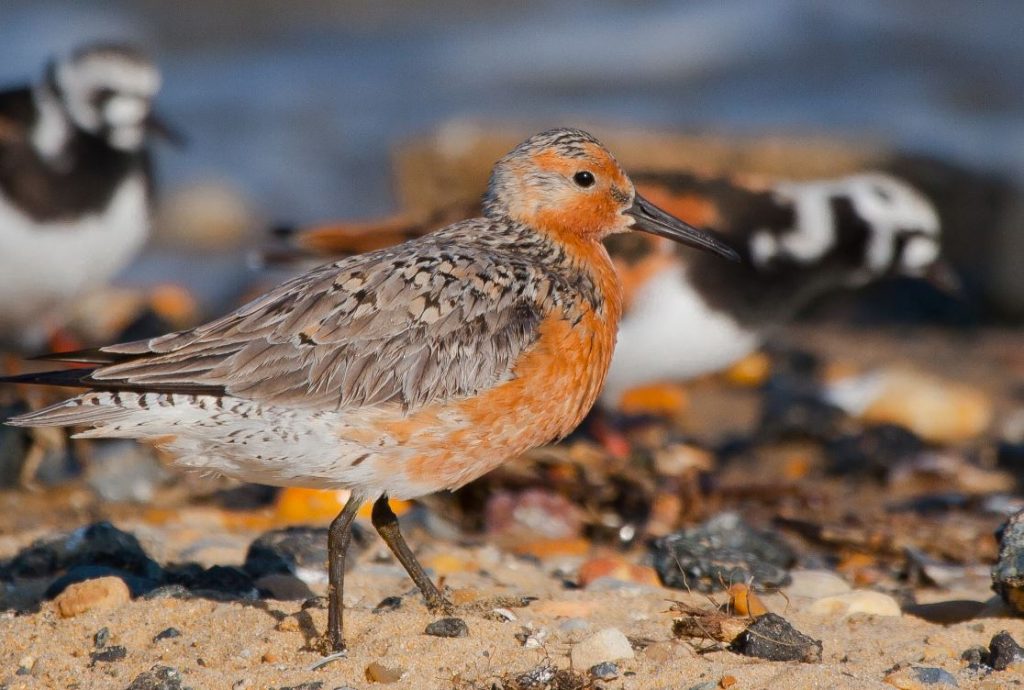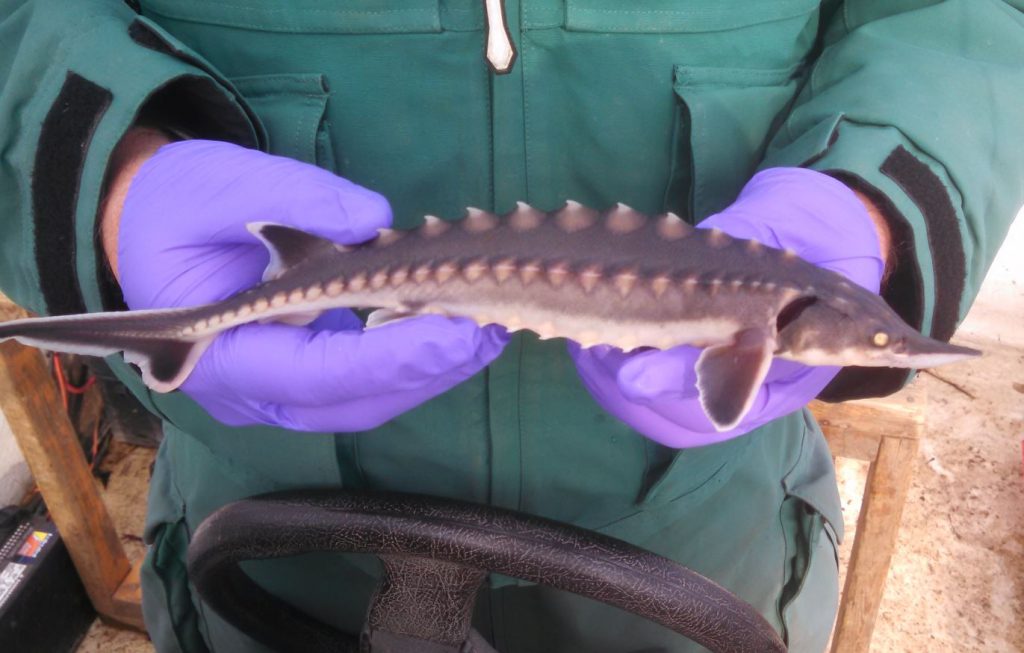By Samantha Robinson
 The red knot, bog turtle, Delmarva fox squirrel and northern long-eared bat are among Delaware’s most endangered species. There are 86 birds, mammals, amphibians, reptiles, fish, mollusks and insects on Delaware’s state endangered species list, which are included in the 689 species considered Species of Greatest Conservation Need (SGCN). Of the more than 2,800 known wildlife and fish species found in Delaware, a quarter are considered SGCN for reasons including habitat loss, disease and climate change.
The red knot, bog turtle, Delmarva fox squirrel and northern long-eared bat are among Delaware’s most endangered species. There are 86 birds, mammals, amphibians, reptiles, fish, mollusks and insects on Delaware’s state endangered species list, which are included in the 689 species considered Species of Greatest Conservation Need (SGCN). Of the more than 2,800 known wildlife and fish species found in Delaware, a quarter are considered SGCN for reasons including habitat loss, disease and climate change.
The Department of Natural Resources and Environmental Control, through its Division of Fish and Wildlife, creates a wildlife conservation blueprint every decade, the Delaware Wildlife Action Plan. This plan provides the outline for helping Delaware fulfill its responsibility to conserve our varied fish and wildlife species and their natural habitats for future generations and keep common species common.
The latest plan, for 2015 to 2025, also fulfills a federal requirement making Delaware eligible for funding under the federal State Wildlife Grant Program. This important program provides funding to help prevent and reverse the decline of Delaware’s wildlife populations and the loss of key habitats. Unfortunately, the amount of federal funding Delaware and other states receive annually from the program is not nearly enough to adequately implement these wildlife action plans to conserve the numerous species in need of conservation.
Congress is considering legislation, the Recovering America’s Wildlife Act (RAWA), to address this shortfall with a new federal funding program that would distribute a total of $1.5 billion annually to states nationwide to implement their wildlife action plans. If this legislation is enacted, Delaware could be eligible for nearly $12 million every year in federal funding to expand conservation and management to restore, conserve, bolster and help prevent the decline of SGCN populations and their habitats. More information about RAWA, including how you can become involved, can be found at the Alliance for America’s Fish & Wildlife.
The Delaware Wildlife Action Plan (DEWAP) identifies and prioritizes 689 fish and wildlife species in Delaware into three tiers. The rarest species are prioritized at Tier 1 – the species in highest need of conservation action. Tier 2 species are of moderate conservation concern and Tier 3 species are still relatively common but may be declining, or are of local or regional importance or concern. The DEWAP also identifies species for which data is needed and extirpated species, such as the bobcat, which once existed in Delaware but was wiped out.

Invertebrates make up 95% of all animal species on Earth and many of these populations are struggling due to the loss of critical habitats, use of some herbicides/insecticides or climate change that threaten their populations. In Delaware, Tier 1 invertebrate species include the iconic monarch butterfly and the American bumblebee.
Other invertebrate types with several species on the SGCN list include various kinds of moths, tiger beetles, dragonflies and damselflies, beetles, fireflies and wild bees. Wildlife biologists are actively conducting surveys throughout Delaware to detect rare, localized populations, such as the Bethany Beach firefly with its distinctive double-green flash found in only a few locations along our southern coastline. A rare ground-nesting bee species, Protandrena abdominalis, was discovered in Delaware for the first time in 2020, with the species inhabiting specific sand habitats where it feeds only on the horsemint plant. Understanding the distribution of invertebrate species statewide helps biologists to conserve those species and their habitats.
Of the 177 species of fish in Delaware, 105 are considered SGCN, seven of which are endangered in the state. Five of these species may now be extinct in Delaware, including the Blue Ridge sculpin and the blackbanded sunfish.
 The Atlantic sturgeon is on federal and state endangered species lists and is imperiled by habitat degradation, spawning barriers, entanglement and vessel strikes. Sandbar and sand tiger sharks are among other species considered to be at-risk in the DEWAP.
The Atlantic sturgeon is on federal and state endangered species lists and is imperiled by habitat degradation, spawning barriers, entanglement and vessel strikes. Sandbar and sand tiger sharks are among other species considered to be at-risk in the DEWAP.
Human activities affecting aquatic systems are the primary cause of the risks including the destruction of habitat, pollution, introduction of non-native species, disease, overharvesting and climate change. Fisheries biologists with the Division of Fish and Wildlife conduct research and monitoring throughout Delaware’s waters to better understand species distribution and to identify and respond to declining fish species.
 Wetland habitat losses, habitat destruction and fragmentation, disease, pollution and climate change have resulted in 65 native amphibian and reptile species being included on the Delaware SGCN list. Tier 1 species include the tiger salamander, barking tree frog, bog turtle, eastern box turtle, red corn snake and plain-bellied water snake. Diamondback terrapin, a Tier 2 species in Delaware, face specific threats due to beach development and vehicle strikes during the breeding season as they venture across roads to find nesting habitat. Programs such as Operation Terrapin Rescue are working to help combat the effects of human impacts on reptile and amphibian survival and reproduction.
Wetland habitat losses, habitat destruction and fragmentation, disease, pollution and climate change have resulted in 65 native amphibian and reptile species being included on the Delaware SGCN list. Tier 1 species include the tiger salamander, barking tree frog, bog turtle, eastern box turtle, red corn snake and plain-bellied water snake. Diamondback terrapin, a Tier 2 species in Delaware, face specific threats due to beach development and vehicle strikes during the breeding season as they venture across roads to find nesting habitat. Programs such as Operation Terrapin Rescue are working to help combat the effects of human impacts on reptile and amphibian survival and reproduction.

There is some good news to report among bird species. The Cooper’s hawk and barred owl were removed from Delaware’s SGCN list during the 2015 Wildlife Action Plan revision as they are no longer considered rare in the state. But there are still 184 bird species on the SGCN list in Delaware, including the saltmarsh sparrow, American kestrel and 19 shorebird species, such as red knot, piping plover and ruddy turnstone.
Habitat loss, predation, invasive species and disease are the main causes for the decline in bird populations in Delaware and worldwide. The Delaware Shorebird Project and Delaware Kestrel Partnership are among the many ways our biologists are working to understand declines in avian species in Delaware, with these programs providing vital data to better manage and conserve these species with a goal of increasing their populations.
 Delaware is home to a wide variety of mammals, 23 of which are species listed on Delaware’s SGCN Tier 1 list: three carnivores, four small mammals, nine bats and seven marine mammals. These high-priority mammals, along with many of the other SGCN mammals, are vulnerable to habitat loss. Small land mammals are also subject to unnatural predation by domestic pets and other predators including raccoons and red foxes whose abundance is often increased by human activities such as feeding or indirectly establishing preferred habitats.
Delaware is home to a wide variety of mammals, 23 of which are species listed on Delaware’s SGCN Tier 1 list: three carnivores, four small mammals, nine bats and seven marine mammals. These high-priority mammals, along with many of the other SGCN mammals, are vulnerable to habitat loss. Small land mammals are also subject to unnatural predation by domestic pets and other predators including raccoons and red foxes whose abundance is often increased by human activities such as feeding or indirectly establishing preferred habitats.
Several bat species are considered SGCN and are state and federally listed as endangered or threatened. Bat species, such as the northern long-eared bat and little brown bat, have experienced recent population declines due to white-nose syndrome, a fungal disease that is threatening bat species across the county. Our biologists are tracking bat populations and the effects of the disease in Delaware by performing bat colony counts and acoustic monitoring of bats. You can help by becoming a bat spotter.
 There is some good news for some endangered mammals in Delaware. Before 1920, Delmarva fox squirrels were common in the state, but they were nationally listed as a federally-listed endangered species by the U.S. Fish and Wildlife Service in 1967 due to habitat loss and extensive timber harvesting. Due to reintroduction and other conservation efforts in Delaware, Maryland and Virginia, the species was removed from the U.S. Endangered Species List in 2015, although the species remains state-listed endangered in Delaware. In an effort to remove this squirrel from Delaware’s endangered species list, additional populations were reintroduced into Delaware from surrounding Delmarva areas in 2020 and 2021, with more squirrels planned for translocation in the spring of 2022. More information on restoring the Delmarva fox squirrel population is further outlined in Delaware’s Delmarva Fox Squirrel Conservation Plan.
There is some good news for some endangered mammals in Delaware. Before 1920, Delmarva fox squirrels were common in the state, but they were nationally listed as a federally-listed endangered species by the U.S. Fish and Wildlife Service in 1967 due to habitat loss and extensive timber harvesting. Due to reintroduction and other conservation efforts in Delaware, Maryland and Virginia, the species was removed from the U.S. Endangered Species List in 2015, although the species remains state-listed endangered in Delaware. In an effort to remove this squirrel from Delaware’s endangered species list, additional populations were reintroduced into Delaware from surrounding Delmarva areas in 2020 and 2021, with more squirrels planned for translocation in the spring of 2022. More information on restoring the Delmarva fox squirrel population is further outlined in Delaware’s Delmarva Fox Squirrel Conservation Plan.
Delaware is home to more than 2,300 plant species, with 69% of those native to the state. Our native plants are subject to the same stressors that affect wildlife species. Although the Delaware Wildlife Action plan does not specifically include plants, since plants are currently not eligible for State Wildlife Grant funding, the Division of Fish and Wildlife prioritizes plant conservation using State Conservation Status ranks. Botanists with the division conduct statewide surveys to document the presence and distribution of rare plants and maintains records on plants and plant communities throughout Delaware.
There are many challenges facing Delaware’s wildlife species and the habitats and ecosystems that support them. Find out what the DNREC Division of Fish and Wildlife is doing to help conserve, protect and enhance our rarest wildlife species and their habitats in part two of our series, “Delaware’s Endangered Species: What DNREC’s Doing to Help.”
Samantha Robinson is Avian Conservation Program Manager with the DNREC Division of Fish and Wildlife.
Related Topics: animals, conservation, education, endangered species, fish and wildlife, habitat, nature, science, wildlife